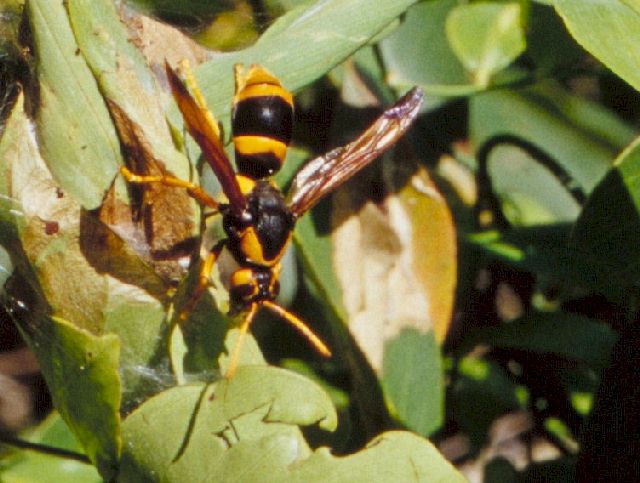Australian
Hornet
Abispa
ephippium (Fabricius)
Identification:
-
Head, antenna and legs orange
-
Mesosoma black with orange
triangle
-
Metasoma wide black band in
middle
Nests:
Behavior:
-
One individual uses a large area
-
Preys only on caterpillars
-
Forages around infested trees and
shrubs.

Picture taken by Markus Barth
Scientific classification:
-
Potter wasps comprise the subfamily
Eumeninae in the family Vespidae, which also contains hornets, yellowjackets,
and paper wasps.
More information:
- Kingdom:
Animalia
- Phylum:
Arthropoda
- Class:
Insecta
- Order:
Hymenoptera
- Family:
Vespidae
- Genus:
Abispa (potter wasps)
Potter Wasp, common name for a group of
caterpillar-hunting wasps known for the pot-shaped mud nests built by some
species. Potter wasps are also known as mason wasps.
The potter wasps are closely related to the paper
wasps. However, potter wasps do not form colonies. Unlike many Vespids, potter
wasps are solitary and build nests that resemble small earthen pots attached to
vegetation or the sides of buildings, often in small groups. Female potter wasps
lay an egg inside each pot which she then stocks with caterpillars for the
developing larvae to feed on. Potter wasp adults feed on flower nectar and
collect small caterpillars to feed their brood. The caterpillars are paralyzed
with the wasp's sting and piled into the brood cell-that is, the compartment in
which the wasp larva develops. The female wasp then lays an egg on the stored
caterpillars. When the larvae are mature they pupate in their
pot and emerge as a fully developed potter wasp. The potter wasp larva consumes
from 1 to 12 caterpillars as it grows.
Potter wasps are important in
the natural control of caterpillars. Although capable of stinging, they are
rarely aggressive and never even bother us!
next page:
Hornet Moth

Hymenoptera>Vespoidea>Vespidae>Vespa
crabro>Hornisse>Hornet>Frelon>Hoornaar>Vespa
grande>Abejorro>Calabrone
Hymenoptera>Vespoidea>Vespidae>Vespa
crabro>Hornisse>Hornet>Frelon>Hoornaar>Vespa grande>Abejorro>Calabrone
Webmaster:
Dieter Kosmeier
Hymenoptera>Vespoidea>Vespidae>Vespa
crabro>Hornisse>Hornet>Frelon>Hoornaar>Vespa grande>Abejorro>Calabrone
Hymenoptera>Vespoidea>Vespidae>Vespa
crabro>Hornisse>Hornet>Frelon>Hoornaar>Vespa grande>Abejorro>Calabrone

www.hornissenschutz.de
www.vespa-crabro.de
|